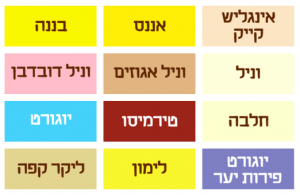 Where to begin?
Where to begin?
Starting the year in a proficiency-oriented Hebrew classroom, where we aim to soak our students in compelling and comprehensible messages, can seem like a daunting task, particularly for teachers new to the strategies, and students who haven’t really heard a lot of connected Hebrew-for-communication before. With any luck, this series of posts will serve as ‘Golden Rails’ to follow, on this first exciting leg of your Teaching with Comprehensible Input (T/CI) journey.
Personalization & Circling Through Surveying
First, select a compelling topic of interest
Criteria:
- Is it developmentally appropriate & compelling for the age group, and topically appropriate for the setting?
- Is it simple, concrete, and can you support it with visuals – gestures, dramatization, sketches, images, props, etc.?
Say I decided to comprehensibly circle the survey question, “Which ice cream do you love?” ?איזה גלידה את אוהבת–
I might:
- Point to the interrogative poster, ?איזה pausing after I say the word

- Pretend to hold and lick my (imaginary) ice cream cone
- Draw a sketch of an ice cream cone and an arrow pointing to the scoop – soon after I say the word and gesture its meaning
- Write the word גלידה with the English translation words, ‘ice cream’ clearly below it, in a contrasting color
- Slowly pause and point, indicating the ‘Super 7’* hi-frequency verb, אוהב/אוהבת
- Gesture the ‘love/s’ verb by forming a heart shape with my hands near my heart
- Check for comprehension, by repeating the Hebrew question, then asking a student, “What am I asking?”
Let’s assume that during the course of my conversation, surveying student after student, I get lots of repetition of similar sentences that contain ‘love’ and it’s negation, ‘doesn’t/don’t love.’
Say I learned from this initial survey question that:
•Tova loves Mint Chocolate Chip
•Gavriel loves Rocky Road
•Alisa loves Moose Tracks, etc.
I can include my own opinion on ice cream, thereby inserting the אני pronoun and voice, as in,
‘אני לא אוהבת גלידת שוקולד מנטה’
As I ask each of my students’ preferred flavor, I compare and contrast loves and dislikes as I move about the room.
‘Tova, you love Mint Chocolate, but you don’t love Rocky Road? Class, who loves Rocky Road? I really love Moose Tracks…and you, Gavriel, do you love Mint…?’
If I wanted, I could offer cognate flavor choices in advance, writing them on the board and pausing/pointing each time.
Otherwise, I write down the flavors in Hebrew or English (names of ice cream are not the goal of the lesson, but do offer opportunities for success in decoding.)
RESOURCE: Familiarize yourself with many borrowed name flavors written in Hebrew with this Hebrew ice cream menu

These are only a few of the many flavors on the menu!
If your class already has solid letter/sound recognition of the Hebrew alphabet, then you may choose, if possible, to project this ice cream menu and decode it together as a class at the end of the oral surveying phase, (skip over the non-cognate flavors – they won’t have meaning) or print it out. Alternatively, copy only the direct cognate flavors onto chart paper, making your own more limited but comprehensible menu.
Back to my students and their flavors:
I notice that all three of the above students love ice cream with chocolate in it. “Ahhh, Tova likes Mint Chip, Gavriel likes Rocky Road and Alisa likes Moose Tracks…they all have chocolate!” – I write the word for ‘has’ in both languages to establish meaning. I gesture ‘has’ by cupping my open hands side by side as if I’m scooping up water. I insure comprehension by telling the students that this is my gesture for יש /have/has.
I encourage the students to use the gestures, too, every time they hear the word.

Then I ask the class and/or individual student for confirmation:
“Class, does Mint Chip ice cream have chocolate?”
“Avi, does Rocky Road ice cream have chocolate?”
“Ya’akov, does Moose Tracks ice cream have chocolate?”
“Class, does Banana ice cream have chocolate?”
I can ask about as many flavors that were mentioned in class as I want – following the demonstrated group interest and energy in the room.
Now, I have used two important hi-frequency verbs in context, ‘love/s’ and ‘have/has’ with their negations, ‘doesn’t love,’ and ‘doesn’t have.’ I am gesturing, pausing/pointing and spot-checking for comprehension as I extend a conversation based on the information I’ve collected. I’m noticing trends in ice cream preference, comparing & contrasting, grouping, counting, and confirming, all within this narrow set of language in use.
I am staying ‘in bounds.’
I make sure to ask a full question each time; that way the verb-containing chunks (love/s; has/have) are always repeated. I gesture the heart shape for ‘loves’ and my hand cupping ‘have/has’ gesture, whenever the words arise. 
‘Tova loves Mint Chip, yes, Tova? You love…? Class, she loves Mint Chip but she doesn’t love…Banana? Tova, do you love Banana?
Class she does love Mint Chip….’
I check for comprehension regularly. What does ‘יש’ mean?“ “What does this (heart gesture) mean?”
“What does, גבריאל לא אוהב גלידת בננה mean?”
Then I move on to a different student, Ester, and ask her what kind of ice cream Tova likes; ask someone else to confirm Alisa’s favorite ice cream, etc. In this way I am constantly recycling the language, checking to make sure the information was understood, and extending the conversation to include more participants. All the while we are communicating and learning about each other as we build our light-hearted community.
I continue comparing and contrasting students and their favorite ice cream until I’ve surveyed everyone in class. I may introduce the connecting words, ‘but,’ and ‘also/too’ as in, ‘I like Moose Tracks ice cream, but Ya’akov loves lemon ice cream.’ Or, ‘Ya’akov loves lemon ice cream and Smadar loves it, too.’
Rule of thumb: If it feels automatic and effortless for the students to understand, then you are in the Sweet Spot. Resist the temptation to pile on more new language. Wait ’til next time. And these new words will have to undergo the full treatment:
-Using them in context
-Writing them on the board with translation, to establish meaning
Pause-point-slow
-Use a gesture / image / prop
-Comprehension check
Some students like fruity flavors. I ask Talia if she (also) likes Moose Tracks. I establish meaning of the word ‘also,’ pausing and pointing to it on the board with each subsequent use, and doing comprehension checks intermittently. She exclaims (in English – no worries) that she’s ‘allergic to chocolate.’ !היא אלרגית לשוקולד
Hurray! a direct cognate. I walk over and tell Tova, Gavriel and Alisa the news – each separately, that Talia doesn’t like their specific ice cream – because she’s allergic (If you choose to use it, establish meaning of ‘because’ on the board in both languages).
How long the oral survey/classroom banter carries on depends on your growing skill in maintaining interest and understanding. We try to reach all the kids in the class in one session, so pace yourself accordingly!
In the next Starting the Year post, learn how to be repetitive without seeming repetitious as you circle your way through PQA….Or is it repetitious without seeming repetitive?
